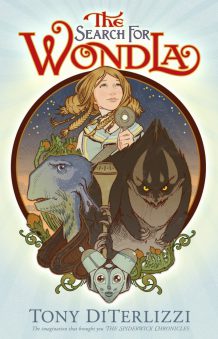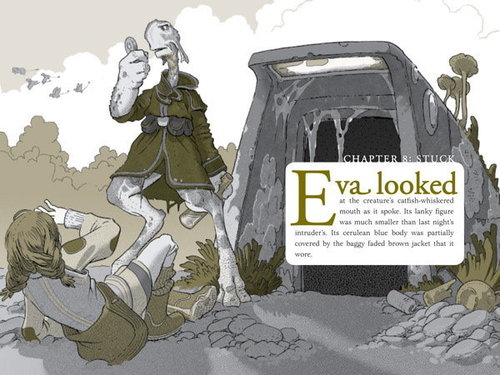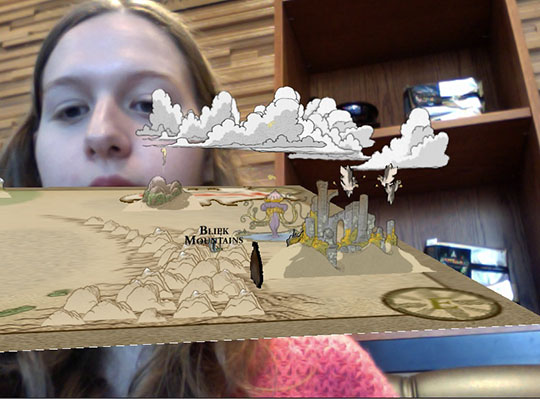A journey in augmented print.
Lost in WondLa
Toni DiTerlizzi, author illustrator of the bestselling Spiderwick Chronicles, took a daring turn when he published The Search for WondLa in 2010. The first in a science-fiction fantasy trilogy for middle-grade readers, WondLa includes an augmented reality (AR) multimedia component that seeks to pull the reader into the series’ futuristic world of Orbona.
Although augmented reality has been used before in various book-marketing campaigns (perhaps most famously in an app used to promote Dan Brown’s The Inferno, inviting readers to “capture the symbols” of the book), The Search for WondLa is the first to incorporate augmented reality into the actual reading experience. This is just the newest addition in a long line of multimedia-rich children’s books. For example, in 2006 Sean Stewart published Cathy’s Book: If Found Call (650)-266-8233 (go ahead, actually call it). The book includes phone numbers, drawings, objects, links to videos and a number of other elements providing clues that help the reader solve the mystery that haunts Cathy throughout the story.
Cathy’s Book and The Search for WandLa are part of this recent trend of “enriching” children’s literature with technological or outside elements. There are so many historical examples that offered an augmented experiences without digital tools—from pop-up books to the Leapfrog Enterprise. In an age of digital disruption, authors and publishers are seeking to unite print and digital in a way that enhances the reading experience. I am interested then in examining the extent to which these multimedia elements change the reader’s relationship with the book as a text and an object, using the example of Toni DiTerlizzi’s The Search for WondLa.
The Search for WondLa centers around a twelve-year-old girl’s search for the human race on a strange planet known as Orbona. Eva Nine has lived her entire life underground with a human-like robot named Muthr, who has taught young Eva how to use modern technologies, such as the Omnipod, a device similar to but more advanced than a computer. An omnipod can learn about the world around it, storing data, projecting holographic images. Eva is just preparing herself for the day that she will be able to go above ground to explore Earth when their home is attacked by a strange creature and she and her droid are forced out. It is then that Eva and Muthr discover they are on a planet that looks nothing like Earth, with trees that walk and strange, alien creatures. Eva is propelled into a search to discover not only where she is but also what happened to the rest of the human race. Along the way, she meets a host of creatures, including Rovender Kit, who helps them on their journey and ultimately becomes something of a father figure for Eva.
The novel is ridden with beautiful two-tone drawings showing what the creatures and the scenery look like. The sheer number of pictures turns a novel that would normally be about 250 pages into a 512-page book. All of Tony DiTerlizzi’s novels are unique in the fact that they are quite visual in nature: vivid character descriptions are often paired with detailed drawings of them, as in the picture of Rovender Kitt above. With The Search for WondLa though, he wanted to take this vivid reading experience a step further, hence WondLa-Vision.
WondLa-Vision is an AR map that uses the web camera on your computer screen to allow you to see yourself in the background as a map opens, creating the illusion of a holographic image. The map is attempting to immerse you in Eva’s world: it moves, zooming in and out as you watch Eva and her crew navigate the world of Orbona on your computer screen. Birds call and Omnipod beeps as you watch (and watch yourself watching) the map.
The map is rendered to look like a 3-D version of DiTerlizzi’s drawings. In reality, it is actually a strange mix of 2-D drawings moving around on a 3-D map. It is a constant reminder that the map is an extension of a book, and rather than immersing the reader in the world of Orbona, the AR map seems more to bring the book into our own world.
In addition to the cartoonish rendering, it would be impossible to analyze WondLa-Vision without discussing the fact that you, the reader, are a part of the map. As I mentioned previously, AR allows you to watch yourself watching the hovering map. You see yourself as a kind of god figure, large and looming over the simplistic 2-D/3-D images. The effect is a strange one that could easily change the relationship between character and reader. In many ways, it may be more difficult to immerse yourself in Eva Nine’s journey (or even empathize with Eva as a character) when you can see yourself as an image projected above her friends and her, more powerful than they are. By the same token, the entire concept of perspective is shifted with WondLa-Vision, for it is not you who is bent over the map but rather a fictionalized version of yourself, a projection of some character who looks like you, immersed in the computerized world. How can you become completely immersed in WondLa-Vision when it is merely a mirrored image of yourself that is experiencing it? And perhaps there are some readers who can suspend disbelief and thrust themselves completely into the experience of WondLa-Vision, but the thought that perspective can get in the way is certainly something to think about.
Another interesting feature of WondLa-Vision is the way that it is accessed. There are three pages in the novel (pages 123, 277 and 433) that have small illustrated keyholes on them, made to look like Eva Nine’s own Omnipod device, which are encoded with information. When you enter the TK Wond-LA website, and hold the keyhole in the book to the keyhole on the WondLa website, the corresponding map for that section is opened.
This kind of experience contains various implications about the print medium. I think that in analyzing it, it would be fruitful examine Marshall McLuhan’s assertion that new technology is always shaped by old technology (McLuhan 42). In this case, the physical book is used as a tool to access the online technology. Without the print book, the reader cannot open the AR map. The two are intrinsically linked, and old technology in this case is a catalyst that brings about new technologies.
This idea of book as key, as talisman, as roadmap is reiterated again and again in almost every aspect of the novel, from the title to WondLa-Vision to the story’s climax. For the majority of the novel, Eva Nine carries with her a small cardboard object bearing the word WondLa and a faded picture of a human walking with a robot. Eva takes this as a sign that humans are still alive and live with robots, as she has her entire life. She sets out to find WondLa, where she believes the human race is living.
In one of the final scenes, Eva and Rovender Kit find themselves underground in a desert known as the Wastelands. They are in some kind of buried library and by scanning the WondLa using an old book check-out device they find out that it is the cover of the novel The Wonderful Wizard of Oz by L. Frank Baum, with all the letters faded away except W-o-n-d-L-a. Eva realizes by searching the archive that they are in the New York Public Library and the world of Orbona is in fact Earth, thousands of years after some kind of alien invasion.
I do not believe it is mere coincidence that DiTerlizzi chose a print book (an object that has been obsolete for over a thousand years in Eva’s world) to be the key to figuring out the secret of Orbona. DiTerlizzi takes McLuhan’s assertion that new mediums are always looking back at old mediums to the extreme. In fact, he has created a book that cannot function in the same way across mediums. In order to access WondLa-Vision, you must use the printed book, not an eBook.
In many ways the novel seems to be an ode to the power of the printed medium. Where the three AR maps cannot be accessed without the physical book and it’s keyholes, the book exists independently of WondLa-Vision. In fact, I did not even open the maps until I was finished reading the book. The maps give no new information; they simply serve as an interesting visual, similar to the two-tone drawings. At the end of the day, at the end of the novel, print reigns king in The Search for WondLa.
Given his bias toward print, it is a wonder that Tony DiTerlizzi would create an online addition such as WondLa-Vision, which when accessed threatens to change and even disrupt the reader’s relationship to the novel. There is something to be said for being able to imagine Eva Nine’s journey on your own rather than watching it on an online map, and ironically WondLa-Vision—DiTerlizzi’s brainchild—seems to unintentionally clash with his own self-proclaimed motto, “Never abandon imagination” (DiTerlizzi).
Works Cited
Diterlizzi, Tony . N.p.. Web. 17 Nov 2013. <http://diterlizzi.com/home/>.
McLuhan, Marshall. The Medium is the Massage. Berkley: Gingko Press, Inc., 2001. Print.





